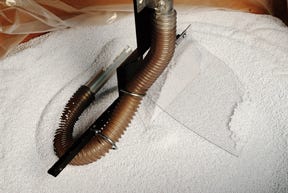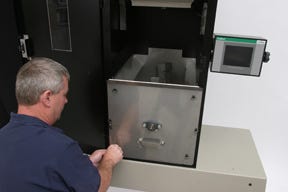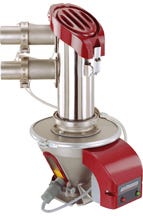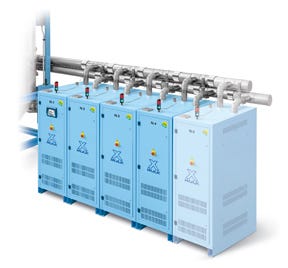Empowering pellet counters
Waste is often only tracked within a mold cavity itself—is the part now cooling inside the tool ready to ship or is it scrap? A molder’s investment in material, however, extends over a broader scope of the process, from transferring resin out of the railcar to drying and beyond, reaching all the way to converting bad parts, runners, and sprues into renewed pellets. Out of every 10 lb delivered to your plant, how many pounds do you sell to customers as finished parts?
September 1, 2010
Waste is often only tracked within a mold cavity itself—is the part now cooling inside the tool ready to ship or is it scrap? A molder’s investment in material, however, extends over a broader scope of the process, from transferring resin out of the railcar to drying and beyond, reaching all the way to converting bad parts, runners, and sprues into renewed pellets. Out of every 10 lb delivered to your plant, how many pounds do you sell to customers as finished parts?
While that specific question might be difficult to answer, a greater material-awareness mindset has become part of most molders’ psyches, particularly processors in the developed world who must mind their costs.
|
“Going back the last five years, I think every single cost associated with the manufacturing process has been scrutinized and evaluated and it’s just tied to economics of being a molder in general,” explains David Purcell, sales manager at molding machine, automation, and auxiliary supplier Wittmann Battenfeld, at its U.S. headquarters in Torrington, CT. “Just run it efficiently, run leaner, and optimize the equipment that you have—less waste generation. I think every single aspect of the molding process is being scrutinized. Material waste is up there in terms of importance when we’re talking about the economics of molding.”
In addition to a desire to remain competitive with lower-cost locales, pellet awareness is a product of highly volatile resin prices, with record highs and precipitous falls seen repeatedly in key commodities like polyethylene and polypropylene just in the last few years.
“Resin prices have been up and down,” Purcell says, “and it’s so difficult for the larger companies to predict where the prices are headed. I know a lot of them try to play it like the stock market, where they’re hedging their prices, but just the fact that there is so much volatility with the resin pricing, it’s responsible to look at all these factors and waste associated with the process and equipment that you have and how much waste is contributed by each component. It all influences the bottom line.”
At Wittmann Battenfeld, this fixation has meant newfound interest in products that are designed to prevent waste prior to the mold cavity. Michael Stark, materials handling division manager at the company, can recall the mostly tepid initial interest in its contact-free RFID-coded couplings, which prevent the wrong material from flowing to the wrong machine. “As of late, probably nine out of the 10 jobs that we’ve been doing,” Stark says, “they’re all coded coupling stations.”
The pellets arrive
The first opportunity to fully use (or waste) pellets comes with their arrival via railcar, truck, or gaylord. Stark says, regardless of how the material is transported, it’s crucial to size the conveying equipment per the application, with the pump specified for that line size to maintain a certain velocity. Proper sizing means you won’t degrade material and end up with dust or angel hairs.
In railcar system, line pressure is used to balance the system, with pellets usually pulled off by vacuum and then blown up into silos. “What we try to do is fine-tune that equipment during a startup,” says Stark, “so that once it arrives, we’ll look at the pressures and we’ll fine-tune it until we reach a certain velocity that’s not going to degrade the material.”
Depending on the bulk density of the material being conveyed, the equipment might require fine-tuning in the field to maintain the ideal velocity. If the material is traveling too fast, the resulting friction buildup can result in strings. “That’s why the velocity is critical,” Purcell says, “to optimize the velocity to avoid the strings so that you’re conveying as much material as quickly as possible without affecting it in a negative way.”
“Those strings mess up your process,” Stark says, “but it’s also flat-out wasted material—same thing with dust. If you have a polycarbonate that you’re conveying at too high of a velocity, then you’ll end up with a filter full of dust at the end of the day and all that dust is really money that’s being thrown away.”
Conscientious conveying
For critical drying applications, processors should also be cognizant of parameters like loader size. In cases where the loader is too large, a batch of dried material can be delivered, with the first half running well, but by the time the bottom of that batch is reached, it has started to regain moisture since it was conveyed with ambient air. At this point, a problematic pattern can emerge. “It’s kind of cyclical,” Stark says. “You have a round of good parts, then they’ll start going bad, then they’ll go good again, then they’ll go bad.”
Wittmann Battenfeld offers processors closed-loop dry-air conveying, where the system applies return air from the dryer for material conveyance. Afterward, the system reintroduces that air back into the dryer via the pump’s exhaust. This design eliminates the need for a secondary drying process at the machine throat, saving energy usage and investment.
Within the dryer, the company points to its intelligent airflow, where the temperature in the hopper is monitored and the amount of air and heat that go into that hopper are carefully metered based on temperature. If your drying system doesn’t do this and a machine goes down and extends the material’s residence time, the result can be best described by a molding-specific euphemism. “You could end up with a Texas pellet,” Stark says. “The material will start to melt and collect in the hopper, and then you have to dig it out with a shovel.”
Common vs. dedicated lines
What will ultimately save you more pellets: a common line fed from a central material handling system, or a series of dedicated lines serving each individual machine? While you may pay more up front for a dedicated-line system due to additional piping, there are two relatively common scenarios where just such a setup can save you material. In a common-line system, you might have extra material in the pipe when you’re switching over from one material to the next, in which case you have to blow out the line, wasting those pellets.
“If you have a row of 15 machines on a common line, and you’re only using the first two of those 15 machines on that particular material,” Stark explains, “the common line ends up filling with material all the way down to the 15th machine.” By the time a molder goes to start up the 15th machine, in most cases he or she would have to purge out all of the material in the line, particularly dried material, because once it’s been sitting in the line for that long, it’s typically no longer processable.
In the second scenario, a dedicated-line system with a coded-coupling station means an operator can’t go up to the manifold to change the material and hook up the wrong resin line. Without this system, and assuming the occasional operator error, by the time a shop figures out the wrong material’s being fed in, resin has already filled the line, as well as the barrel of the machine, in addition to shooting a few parts. “By using the RFID-coded coupling station, we eliminate the human error of sending the wrong material to the wrong machine,” Stark says. “We eliminate the wasted parts and the wasted plastic associated with that.”
Pellet-preserving technologies
In a molding shop, perhaps the largest single source of wasted pellets are purgings. In 2009, auxiliary equipment supplier Maguire Products Inc. (Aston, PA) launched its Purging Recovery System: a two-stage machine that first slices or planes the lumps of plastic into small pieces, and then reduces those slices into uniform regrind. Maguire sells the entire system, including the second-stage compact granulator, for $28,000.
Estimating that purgings typically range in size from 1-10 lb (0.45-4.5 kg) and may be generated at a rate of a few to dozens per shift in a custom molding shop where color and material changes are frequent, a processor using resin that costs $1.00/lb could potentially reclaim hundreds of dollars worth of raw material every week. (Read details on the system in our initial report at plasticstoday.com; search for “purging recovery system.”)
Maguire has also targeted pellet waste prior to molding with its Sweeper technology. Molders that process materials primarily delivered in gaylord boxes often struggle to use every pellet in a box, relying on operators or box tilters to empty a gaylord completely. Maguire’s Sweeper continuously sweeps the length and breadth of the top level of resin in the container, reaching into every corner, and using a vacuum to transfer the resin to a processing machine or dryer.
The device descends with the level of resin until the container is empty. Because the Sweeper removes resin from the gaylord without interruptions, there is no need for operators to stand by to ensure that the processing machine does not run out of material or that undried material does not enter the process.
Auxiliary supplier AEC (Schaumburg, IL) emphasizes efficiency with its BD Blender Series, ready to debut at the K 2010 show (Stand 9D23). With throughputs of 10-6000 lb/hr, the BD Series can blend two to eight components. Easing access for emptying material at changeovers, a removable weigh hopper is standard. Further targeting potential waste is the adjustable slide-gate stroke limiter for accurate metering of minor ingredients.
Italian auxiliary supplier Moretto (Massanzago) puts forward its automatic high-volume modular drying systems, which combine its X Max dryer, Flowmatik control, and OTX hopper as a model of material efficiency. Capable of throughputs up to 8000 kg/hr, the system gives processors the flexibility of using three to 10 dryer units and one to 32 drying hoppers, all without requiring compressed air or cooling water. For highly hygroscopic polymers like polyethylene terephthalate (PET), the result is faster, consistent, and gentler drying.The Flowmatik control detects each hopper’s capacity and the material’s bulk density to compute desired resident time, temperature, and the air-flow rate.
The Conair Group’s (Cranberry Township, PA) TrueBlend blender line can now be equipped with a compressed-air self-cleaning system, making it possible to change colors automatically without manual cleaning, saving pellets in the process. The company says that, with as many as 12 ingredient bins on a single blender, a molder can stage multiple colors and change from one to another on the fly, with the compressed-air cleanout system purging each color before the next run begins.
As the end of a particular color run nears, the flow of material from that bin is shut off. Successive blasts of compressed air sweep any remaining pellets first out of the blender weigh bin, then the mixing chamber, then the surge bin below the mixer, and finally the pocket conveying valve beneath the surge bin. At this point, the conveying lines and material receiver on the molding machine are blown clean before a new color is blended with natural and conveyed to the press.
In addition, the TrueBlend control uses an improved algorithm to analyze dozens of weight readings in a matter of milliseconds, filtering out electronic noise and vibration effects. A diagnostic screen displays target setpoint percentage and actual percentage dispensed, and dynamically displays start and finish weights for each material per batch. A material-use reporting capability weighs every ingredient dispensed to ensure that each blended batch is accurate to within a fraction of a percent. That data can be used to generate reports, identify just-in-time purchase requirements, analyze and validate product material usage estimates, or, to please the pellet counters, calculate process yield vs. waste. —Tony Deligio
1. 
2. 3. 4. 5.
About the Author(s)
You May Also Like







